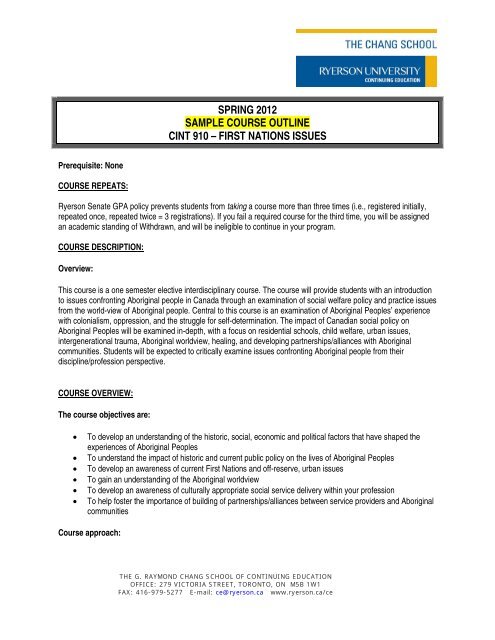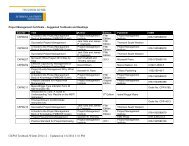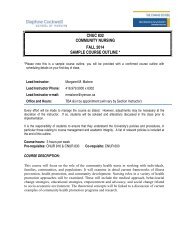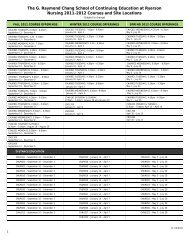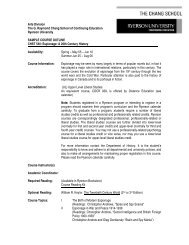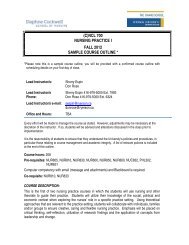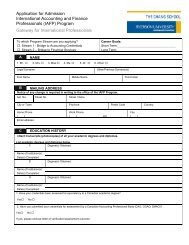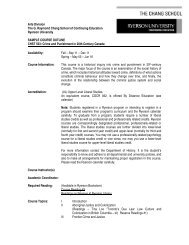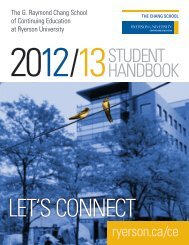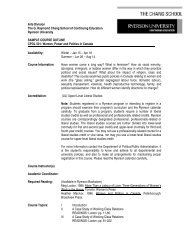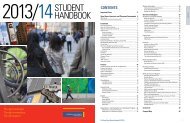CINT 910 - The Chang School
CINT 910 - The Chang School
CINT 910 - The Chang School
You also want an ePaper? Increase the reach of your titles
YUMPU automatically turns print PDFs into web optimized ePapers that Google loves.
SPRING 2012<br />
SAMPLE COURSE OUTLINE<br />
<strong>CINT</strong> <strong>910</strong> – FIRST NATIONS ISSUES<br />
Prerequisite: None<br />
COURSE REPEATS:<br />
Ryerson Senate GPA policy prevents students from taking a course more than three times (i.e., registered initially,<br />
repeated once, repeated twice = 3 registrations). If you fail a required course for the third time, you will be assigned<br />
an academic standing of Withdrawn, and will be ineligible to continue in your program.<br />
COURSE DESCRIPTION:<br />
Overview:<br />
This course is a one semester elective interdisciplinary course. <strong>The</strong> course will provide students with an introduction<br />
to issues confronting Aboriginal people in Canada through an examination of social welfare policy and practice issues<br />
from the world-view of Aboriginal people. Central to this course is an examination of Aboriginal Peoples’ experience<br />
with colonialism, oppression, and the struggle for self-determination. <strong>The</strong> impact of Canadian social policy on<br />
Aboriginal Peoples will be examined in-depth, with a focus on residential schools, child welfare, urban issues,<br />
intergenerational trauma, Aboriginal worldview, healing, and developing partnerships/alliances with Aboriginal<br />
communities. Students will be expected to critically examine issues confronting Aboriginal people from their<br />
discipline/profession perspective.<br />
COURSE OVERVIEW:<br />
<strong>The</strong> course objectives are:<br />
• To develop an understanding of the historic, social, economic and political factors that have shaped the<br />
experiences of Aboriginal Peoples<br />
• To understand the impact of historic and current public policy on the lives of Aboriginal Peoples<br />
• To develop an awareness of current First Nations and off-reserve, urban issues<br />
• To gain an understanding of the Aboriginal worldview<br />
• To develop an awareness of culturally appropriate social service delivery within your profession<br />
• To help foster the importance of building of partnerships/alliances between service providers and Aboriginal<br />
communities<br />
Course approach:<br />
THE G. RAYMOND CHANG SCHOOL OF CONTINUING EDUCATION<br />
OFFICE: 279 VICTORIA STREET, TORONTO, ON M5B 1W1<br />
FAX: 416-979-5277 E-mail: ce@ryerson.ca www.ryerson.ca/ce
This course focuses on the question, “How can community services be delivered in a manner that is relevant to<br />
Aboriginal Peoples?” Students will share critical thinking on how their role as potential service providers is impacted<br />
by the demand for culturally relevant social services delivery.<br />
Learning Environment<br />
We have a social responsibility, as professional, to treat one another with respect. We must respect others’ views<br />
even if we do not agree with their viewpoint. It must be recognized that having core values challenged, even<br />
respectfully, may be an unsettling experience, but it is an inevitable aspect of learning. <strong>The</strong>refore, we must challenge<br />
the ideas people present, rather than attack the person who presents the ideas. Mutual respect and consideration for<br />
each other and our ideas form the basis for fostering classroom safety. However, we must ensure, not assume, that<br />
respect for one another exists within the interdisciplinary profession.<br />
Accessibility and Special Needs<br />
Students with accessibility issues and special needs are encouraged to get in touch with the instructors as early as<br />
possible to ensure that appropriate adaptation, support, and/or accommodation are in place.<br />
TEXTS & READING LISTS:<br />
Reading requirements:<br />
Students are expected to read two of the readings under each topic below before class and<br />
participate in class discussions.<br />
Required Texts:<br />
Readings for <strong>CINT</strong><strong>910</strong> - First Nations Issues.<br />
Additional References<br />
• American Psychiatric Association. (2000). Diagnostic and statistical manual of mental disorders. Fourth<br />
Edition. Washington, D.C.: American Psychiatric Association.<br />
• Benton -Benai, E. (1979). <strong>The</strong> Mishomis book: <strong>The</strong> voice of the Ojibway. Saint Paul: Indian Country Press.<br />
• Bolt, M. (1993). Surviving as Indians. Toronto: University Of Toronto Press.<br />
• Hanselmann, C. (2001). Urban Aboriginal people in western Canada: Realties and policies. Calgary:<br />
Canada West Foundation.<br />
• Kingsley, C., & Mark, M. (2000). Sacred lives: Canadian Aboriginal & youth speak out about sexual<br />
exploitation. Vancouver: Save the Children.<br />
• Knockwood, I. (1992). Out of the depths. Lockport: Roseway Publishing.<br />
• LaPrairie, C. (1995). Seen but not heard: Native people in the inner city. Ottawa: Department Of Justice<br />
Canada.<br />
• Lee, K. (1999). Measuring poverty among Canada’s Aboriginal people. Perception, 23, (2), 9-12.<br />
• Miller, J.R. (1996). Shingwauk’s vision. Toronto: University Of Toronto Press.<br />
• Peters, E. (1992). Self-Government for Aboriginal people in urban areas: a literature review and suggestion<br />
for research. <strong>The</strong> Canadian Journal of Native Studies, 12 (1), 1-74.<br />
• Royal Bank of Canada, CANDO. (1997). <strong>The</strong> cost of doing nothing: A call to action. Toronto: Author.<br />
2
• Royal Commission on Aboriginal Peoples. (1994). Public hearing: discussion paper 2 - towards<br />
reconciliation - overview of the fourth round. Ottawa: Minister of Supply and Services Canada.<br />
• Mussell, J., Nicholls, W.M., & Adler, M.T. (1991). Making meaning of mental health challenges in First<br />
Nations: A Freirean perspective. Chiliwack: Saltshan Institute Society.<br />
• Spence, B. (1988). Urban Indian, special report city Indians: Refugees from Saskatchewan reserves.<br />
[http://.sicc.sk.ca/saskindian/a88may19.htm].<br />
• Wagamese, R. (1994). Keeper’n me. Toronto: Doubleday Canada.<br />
• York, G. (1989). <strong>The</strong> dispossessed. Toronto: Little, Brown & Co.<br />
E-MAIL ACCOUNTS:<br />
Students are required to activate and maintain a Ryerson Matrix e-mail account. This shall be the official means by<br />
which you will receive university communications. See http://www.ryerson.ca/senate/policies/pol157.pdf.<br />
Student emails will be returned within three academic days. Emails on the weekend will be returned at the beginning<br />
of the week. All students are expected to compose emails in a professional manner. Messages using excessive<br />
internet abbreviations will not be answered.<br />
All students are expected to use their Ryerson email address for all communications with their instructor.<br />
EVALUATION:<br />
Evaluation:<br />
Article Reviews 20%<br />
• Students will review two articles from the required reading below for different topic areas and provide a<br />
maximum one page critical review, including how the article relates to their discipline/profession. <strong>The</strong> first<br />
article review is due during the week of classes<br />
Class Participation 10%<br />
• Given that this is a one week intensive course, students are expected to attend all classes and actively<br />
participate in class discussions. Attendances will be taken.<br />
Group Presentation 30%<br />
• Small group exercise will allow students an opportunity to examine an issue in-depth from their<br />
discipline/profession perspective and present their findings to the class. Groups will provide a 45-minute<br />
presentation, facilitate class discussion and distribute a two-page synopsis of their presentation,<br />
incorporating Aboriginal self -determination, the intent and impact of any suggested interventions and the<br />
role of the discipline/profession as a partner/ally in the process should be included.<br />
Research Paper 40%<br />
• Students will develop an eight to ten page research paper on a topic related to Aboriginal issues and their<br />
discipline/profession, not including title page or references. Papers are to include a section on<br />
partnerships/alliance building. Essays are due approximately two weeks after the class.<br />
General guidelines for course assignments:<br />
Citations and references in the essay shall be in accordance with the American Psychological Association (APA)<br />
standard. <strong>The</strong> APA publication manual is available for reference in the Ryerson Library, on-line or may be purchased<br />
at the Ryerson Bookstore.<br />
Essays are to be double-spaced, have one-inch margins, and be in Times New Roman or Arial 12-point font.<br />
3
Spelling, punctuation, and grammatical accuracy will be considered in the grading.<br />
Students are encouraged to focus their essay on an area explored earlier in either the article reviews, group<br />
presentation and should be related to the students chosen discipline/profession.<br />
Provide a bibliography of texts and other relevant publications / sources cited as references for the essay. A<br />
minimum of 10 publications/sources is required for the essay, and up to five articles from the readings can be used.<br />
A group mark will be assigned for the presentation based on collaborative participation of group members, creativity,<br />
engagement of class, organization, clarity and understanding and analysis of the topic.<br />
If you would like to receive your final paper back, please include a self-addressed stamped envelope and the final<br />
paper will be mailed to you.<br />
Late Policy:<br />
A request for an extended deadline for an assignment will be given only on medical or compassionate grounds. If a<br />
request for an extension is required, a written Request for an Extension Date must be submitted before the due<br />
date. Assignments not submitted on time or by the extended deadline will be deemed late. Late assignments will<br />
receive the following demerits: Up to and including 4 days late, one full step on the grading scale (i.e. B will become<br />
C). Papers not received by 12:00 p.m. on the fifth day will not be graded.<br />
TOPICS – SEQUENCE & SCHEDULE<br />
Day 1 - Morning - Introduction and Understanding the Historical Context<br />
Churchill, W. (1995). Since predator came: Notes from the struggle for American Indian liberation. Colorado: Aigis<br />
Publications.<br />
Mann, C. C. (March 2002). America before Columbus - 1491. <strong>The</strong> Atlantic Monthly, 289 (3) 41-53.<br />
Miller, J.R. (2000). Early contacts in the Eastern Woodlands in Skyscrapers hide the heavens: A history of Indian<br />
relations in Canada. Toronto: University of Toronto Press.<br />
Royal Commission on Aboriginal Peoples. (1996). Volume 1: Looking forward, looking back. Ottawa: Minister of<br />
Supply and Services Canada. Chapter 3 & 9.<br />
Samson, C., Wilson, J., & Mazower, J. (1999). Canada’s Tibet: <strong>The</strong> killing of the Innu. London: Survival. Pages 9 -18.<br />
Day 1 - Afternoon - Residential <strong>School</strong>s<br />
Bull, L. (1991). <strong>The</strong> Indian residential schooling: <strong>The</strong> Native perspective. Canadian Journal of Native Education, 18,<br />
3-63.<br />
Ing. R. (1991). <strong>The</strong> effects of residential schools on Native child-rearing practices. Canadian Journal of Native<br />
Education, 18, 65-118.<br />
Miller, J. (1987). <strong>The</strong> irony of residential schooling. Canadian Journal of Native Education, 14 (2), 3-11.<br />
Miller, J.R. (1996). To have the Indian educated out of them: Classroom and class in Shingwauk’s vision: A history of<br />
Native residential schools. Toronto: University of Toronto.<br />
Scott-Brown, J. (1987). <strong>The</strong> short life of St. Dunstan’s Calgary Indian industrial school, 1896-1907. Canadian Journal<br />
of Native Education, 14 (1) 41-49.<br />
Day 2- Morning - Child Welfare Policies<br />
4
Andres, R. (1981). <strong>The</strong> apprehension of Native children. Ontario Indian, 46, 32- 37.<br />
Carasco, E. F. (1986) Canadian Native children: Have child welfare laws broken the circle? Canadian Journal of<br />
Family Law, 5, 111-138.<br />
Hudson, P., & McKenzie, B. (1981). Child welfare and Native people: <strong>The</strong> extension of colonialism. <strong>The</strong> Social<br />
Worker, 49(2), 63-88.<br />
Horejsi, C., Heavy Runner Craig, B., & Pablo, J. (1992). Reaction by Native American parents to child protection<br />
agencies: Cultural and community factors. Child Welfare, 71, 329-342.<br />
Palmer, S., & Cooke, W. (1996). Understanding and countering racism with First Nations children in out-of-home<br />
care. Child Welfare, 75 (6), 709-725.<br />
Day 2 - Afternoon - Urban Issues<br />
Brody, H. (1971). Indians on skid row. Ottawa: Department of Indian Affairs and Northern Development.<br />
Harding, J. (1966). Canadian’s Indians: A powerless minority. In J. Harp and J. Hofley (Eds.). Poverty in Canada.<br />
Scarborough: Prentice-Hall of Canada, Ltd.<br />
Indian-Eskimo Association Of Canada. (1966). National conference on Indians and the city. Winnipeg: Author.<br />
Peters, E. (1996). Aboriginal people in urban Areas. In Long, D., & Dickson, O. (Ed). Visions of the heart: Canadian<br />
Aboriginal issues. Toronto: Harcourt Brace & Company.<br />
Laird, G. (2002). <strong>The</strong> streets of Iqualuit. This Magazine, 35 (5). Toronto: Red Maple Foundation.<br />
Williams, A. (1997). Canadian urban Aboriginals: A focus on Aboriginal women in Toronto. <strong>The</strong> Canadian Journal of<br />
Native Studies, 17 (1), 76-101.<br />
Day 3 - Morning - Intergenerational Trauma<br />
Duran, E., & Duran, B. (1995). Native American postcolonial psychology. New York: State University of New York.<br />
Press.<br />
Gagne, M. (1998). <strong>The</strong> role of dependency and colonialism in generating trauma in First Nations citizens. In Y.<br />
Danieli (Ed.), International handbook of multigenerational legacies of trauma. New York: Plenum Press.<br />
Kirmayer, L., Brass, G., & Tait, C. (2000). <strong>The</strong> mental health of Aboriginal peoples: Transformation of identity and<br />
community. Canadian Journal of Psychiatry, 45 (7), 607-616.<br />
Locust, C. (1999). Split feathers: Adult American Indians who were placed in non-Indian families as children.<br />
Pathways, 14 (1), 1-5.<br />
Root, M. (1992). Reconstructing the impact of trauma on personality. In Brown, L. and Ballou, M. (Eds.) Personality<br />
and psychopathology: Feminist reprisals. New York: <strong>The</strong> Guilford Press.<br />
Robert, W.R., Chester., B., & Goldman, D. (2001). Cumulative trauma and PTSD in American Indian communities. In<br />
Marsella, A., Friedman, M., Gerrity., E., & Scurfield, R. (Ed), Ethnocultural Aspects of posttraumatic stress disorder.<br />
Washington: American Psychological Association.<br />
Day 3 - Afternoon - Aboriginal Worldview<br />
Brant, C. (1990). Native ethics and rules of behaviour. Canadian Journal of Psychiatry, 35 (3), 534-539.<br />
Cayete, G. (1994). Looking to the mountain: Ecology of Indigenous knowledge. Durango: Kivaki Press.<br />
5
Good Tracks, G. (1973). Native American non-Interference. Social Work, 18 (11), 30-34.<br />
Hanson DuBray, W. (1985). American Indian values: critical factor in casework. Social Casework: the Journal of<br />
Contemporary Social Work, 66(1), 30-37.<br />
Horejsi, C., & Pablo, J. (1993). Traditional Native American cultures and contemporary U.S. society: A comparison.<br />
Human Services in the Rural Environment, 16 (3), 24-27.<br />
Day 4 - Morning - Aboriginal Healing<br />
Duck, J., Ironstar, V., & Ricks, F. (1997). Healing and the community. Journal of Child and Youth Care, 11 (3), 1-13.<br />
Duran, E., Duran, B., Yellow Horse Brave Heart, M., & Yellow Horse-Davis, S. (1998). Healing the American Indian<br />
soul wound. In Y. Danieli (Ed.), International handbook of multigenerational legacies of trauma. New York: Plenum<br />
Press.<br />
Dutton, M. (1998). Cultural issues in trauma treatment. Centering 3, (2) pp.1-2. [Available on line at:<br />
http://www.thecenteratpiw.com].<br />
Lederman, J. (1999). Trauma and healing in Aboriginal families and communities. Native Social Work Journal, 2 (1),<br />
59-90.<br />
Morrissette, V., McKenzie, B., & Morrissette, L. (1993). Towards an Aboriginal model of social work practice.<br />
Canadian Social Work Review, 10 (1), 91-108.<br />
Day 4 - Afternoon - Organizations<br />
Chapman, I., McCaskill, D., & Newhouse, D. (1991). Management In contemporary Aboriginal organizations. <strong>The</strong><br />
Canadian Journal of Native Studies, 1 (2), 33-349.<br />
Jordon, D.F. (1986). Aboriginal Identity: <strong>The</strong> Management Of A Minority Group by the mainstream society. <strong>The</strong><br />
Canadian Journal of Native Studies, 6(2), 271-311.<br />
Repath, L. (1997). A comparison of Native culture, non-Native culture and new management ideology. Canadian<br />
Journal of Administrative Sciences.<br />
Royal Commission on Aboriginal Peoples. (1996). Volume 3: Gathering strength. Ottawa: Minister of Supply and<br />
Services Canada. Pages 294-314.<br />
Day 5 - Morning - Group presentations<br />
Day 5 - Afternoon - Group presentations<br />
Wrap-up<br />
6


